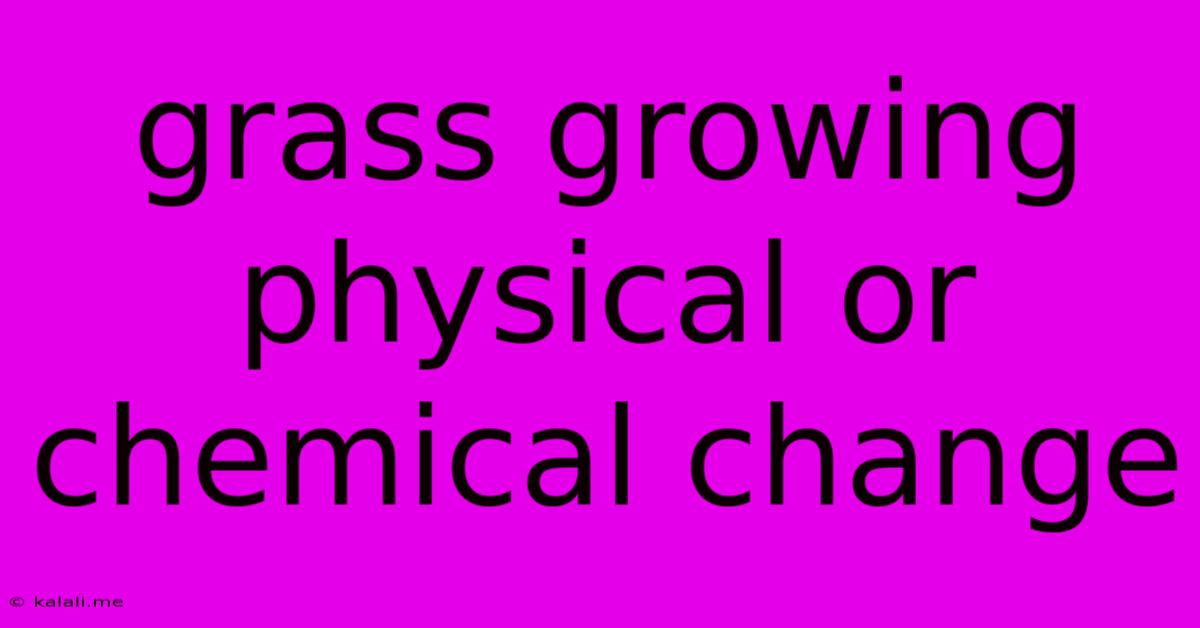Grass Growing Physical Or Chemical Change
Kalali
May 09, 2025 · 3 min read

Table of Contents
Is Growing Grass a Physical or Chemical Change? Understanding the Processes
The seemingly simple act of grass growing actually involves a complex interplay of physical and chemical processes. While it might appear purely physical at first glance – something simply getting bigger – a deeper look reveals the crucial role of chemical reactions in this fundamental biological process. This article will delve into the specifics, explaining why grass growth is primarily a chemical change, with supporting physical aspects.
Grass growth, at its core, is driven by chemical reactions. Photosynthesis, the process by which plants convert light energy into chemical energy in the form of sugars (glucose), is a cornerstone of this growth. This chemical reaction involves carbon dioxide from the air and water absorbed from the soil, catalyzed by chlorophyll in the presence of sunlight. The resulting glucose then fuels the plant’s cellular processes, leading to the synthesis of new cells and, consequently, growth.
Chemical Changes Driving Grass Growth:
- Photosynthesis: As mentioned above, this is the primary chemical reaction driving grass growth. The conversion of light energy into chemical energy (glucose) is a fundamental chemical transformation.
- Respiration: The process of respiration is the reverse of photosynthesis, where glucose is broken down to release energy for the plant's functions. This is also a crucial chemical reaction contributing to the plant's overall growth and development.
- Nutrient Uptake and Metabolism: Grass absorbs essential nutrients from the soil, like nitrogen, phosphorus, and potassium. These nutrients are then incorporated into various chemical compounds within the plant through a series of complex metabolic reactions, facilitating growth and development. This includes the formation of proteins, carbohydrates, and other essential biomolecules.
- Enzyme Activity: Countless enzyme-catalyzed reactions are constantly occurring within grass cells. Enzymes are biological catalysts that accelerate the rate of chemical reactions, making them essential for all aspects of grass growth, from photosynthesis to protein synthesis.
Physical Changes Accompanying Grass Growth:
While the core of grass growth is chemical, several physical changes accompany it:
- Increased Size and Mass: The obvious physical change is the increase in size and mass of the grass plant as new cells are formed and added. This is a direct result of the chemical processes discussed above.
- Cell Division and Elongation: The process of cell division and elongation are physical changes where existing cells divide to form new cells and existing cells increase in length. However, these processes are driven by underlying chemical reactions.
- Water Absorption and Transpiration: Grass absorbs water through its roots and loses water through transpiration (evaporation from leaves). This water movement is a physical process, but it's essential for transporting nutrients and maintaining the plant's turgor pressure, which is crucial for growth.
Conclusion:
In summary, while physical changes are observed in the growth of grass—increased size, cell division—the driving force behind this growth is entirely dependent on a series of complex chemical reactions, most notably photosynthesis, respiration, and nutrient metabolism. These chemical processes synthesize new cellular components, ultimately leading to the observable physical changes associated with grass growth. Therefore, grass growth is best classified as a chemical change with significant accompanying physical manifestations.
Latest Posts
Related Post
Thank you for visiting our website which covers about Grass Growing Physical Or Chemical Change . We hope the information provided has been useful to you. Feel free to contact us if you have any questions or need further assistance. See you next time and don't miss to bookmark.